Tales from the West Side: An In-Depth Look at the Evolution of WEST SIDE STORY
"Two households, both alike in dignity,
In fair Verona, where we lay our scene,
From ancient grudge break to new mutiny,
Where civil blood makes civil hands unclean.
From forth the fatal loins of these two foes
A pair of star-cross'd lovers take their life;
Whose misadventur'd piteous overthrows
Doth with their death bury their parents' strife.
The fearful passage of their death-mark'd love,
And the continuance of their parents' rage,
Which, but their children's end, nought could remove,
Is now the two hours' traffic of our stage;
The which if you with patient ears attend,
What here shall miss, our toil shall strive to mend."
-William Shakespeare, Romeo and Juliet
 In the mid 1940s, an actor paid a visit to his longtime friend, choreographer and director, Jerome Robbins. Having recently been cast as Shakespeare's star-crossed male lead, Romeo Montague, in the Bard's tragic tale of Romeo & Juliet, he sought Robbins' expert opinion on how to bring the character to life in a new and modern way. This innocuous brainstorming session between two artists would spark the idea for what would become one of the most seminal and beloved shows in the musical theatre canon, West Side Story.
In the mid 1940s, an actor paid a visit to his longtime friend, choreographer and director, Jerome Robbins. Having recently been cast as Shakespeare's star-crossed male lead, Romeo Montague, in the Bard's tragic tale of Romeo & Juliet, he sought Robbins' expert opinion on how to bring the character to life in a new and modern way. This innocuous brainstorming session between two artists would spark the idea for what would become one of the most seminal and beloved shows in the musical theatre canon, West Side Story.
Sparking the now time-honored tradition of plopping Shakespeare's body of public domain classics into various settings and time periods, Robbins' goal was to use the bones of his most famous romance to tell a modern story.
After its Broadway debut in September 1957, West Side Story instantly earned a place as a history-making smash. Building on the legacy of Rodgers and Hammerstein's Oklahoma!, the show marked a significant departure from the commercial musical theatre fare of the day. A dark and dense musical drama, West Side Story dramatized the race and class struggle between Puerto Rican immigrants and their established Caucasian counterparts in New York City.
The creative journey of West Side Story, however, does not begin and end with Robbins' stroke of brilliance to turn Shakespeare's most famous love story into a contemporary musical, nor on its history-making opening night. More so than maybe any other musical ever, West Side Story exists as a living document, with each succeeding iteration undergoing some element of significant transformation since its debut.
The story behind Story begins following Jerome Robbins' meeting with the aforementioned actor friend. The discussion had sparked an epiphany within the famed choreographer and he began to dream up the bones of a contemporary musical retelling of Shakespeare's romantic tragedy.
Replacing the Capulets and Montagues with the Catholic 'Jets' and Jewish 'Emeralds' the story would swap fair Verona for the highly compartmentalized immigrant  communities on New York City's Lower East Side. Initially meant to explore anti-Semitism, Robbins' story told of a female Holocaust survivor, Dorrie, and her family who had recently immigrated from Israel. When she meets and falls in love with an Irish-Catholic boy, Tonio, their romance sparks a gang war on the week of Passover and Easter.
communities on New York City's Lower East Side. Initially meant to explore anti-Semitism, Robbins' story told of a female Holocaust survivor, Dorrie, and her family who had recently immigrated from Israel. When she meets and falls in love with an Irish-Catholic boy, Tonio, their romance sparks a gang war on the week of Passover and Easter.
Robbins' approached Gypsy book writer, Arthur Laurents, and symphonic composer, Leonard Bernstein, to work on the adaptation soon after. As work began, disagreements among the team arose immediately as each artist seemed to have different goals for the project. Robbins hoped to create a street ballet, Laurents sought to write a modern drama, and Bernstein saw it as an operatic tragedy. The three eventually settled on what Robbins termed, a "lyric theatre" style.
When Laurents turned in a first draft of the book, then titled East Side Story, upon examining the script, all three agreed that that their story was treading ground already covered by plays such as Abie's Irish Rose. As scheduling conflicts and creative disputes continued among the team of artists, by 1949 the project was shelved.
Development would not resume until Laurents and Bernstein met at The Beverly Hills Hotel a few years later. When their discussion of current events turned to Chicano gang turf wars taking place in Los Angeles, Bernstein, a lover of Latin music, suggested moving East Side Story's setting to LA's Mexican community. Laurents, a New Yorker, knew nothing of life in Los Angeles and instead pointed to the rapidly growing population of Puerto Rican immigrants currently making their way into Manhattan as the basis of the story.
Seeking better jobs and wages, the great postwar 'Migracion' had seen record numbers of Puerto Ricans turning up in New York City. By 1953, nearly 100,000 Puerto Ricans were living and working in New York, while facing abhorrent discrimination from their fellow immigrants - Italians, Poles, Irish, and Jews - who had preceded them.
Bernstein and Laurents agreed on the premise and put in a call to Jerome Robbins who approved the idea. As their new concept bloomed, Laurents adjusted the show's setting for geographic accuracy, with the action of the play now taking place across town, earning the musical its title, West Side Story.
As development resumed, a slew of additional changes would be made in order to craft the world of the show. In terms of story, the first departure came with the transformation of warring religious communities into two ethnically opposed teenage street gangs, the Puerto Rican 'Sharks' and the Caucasian 'Jets'. The star-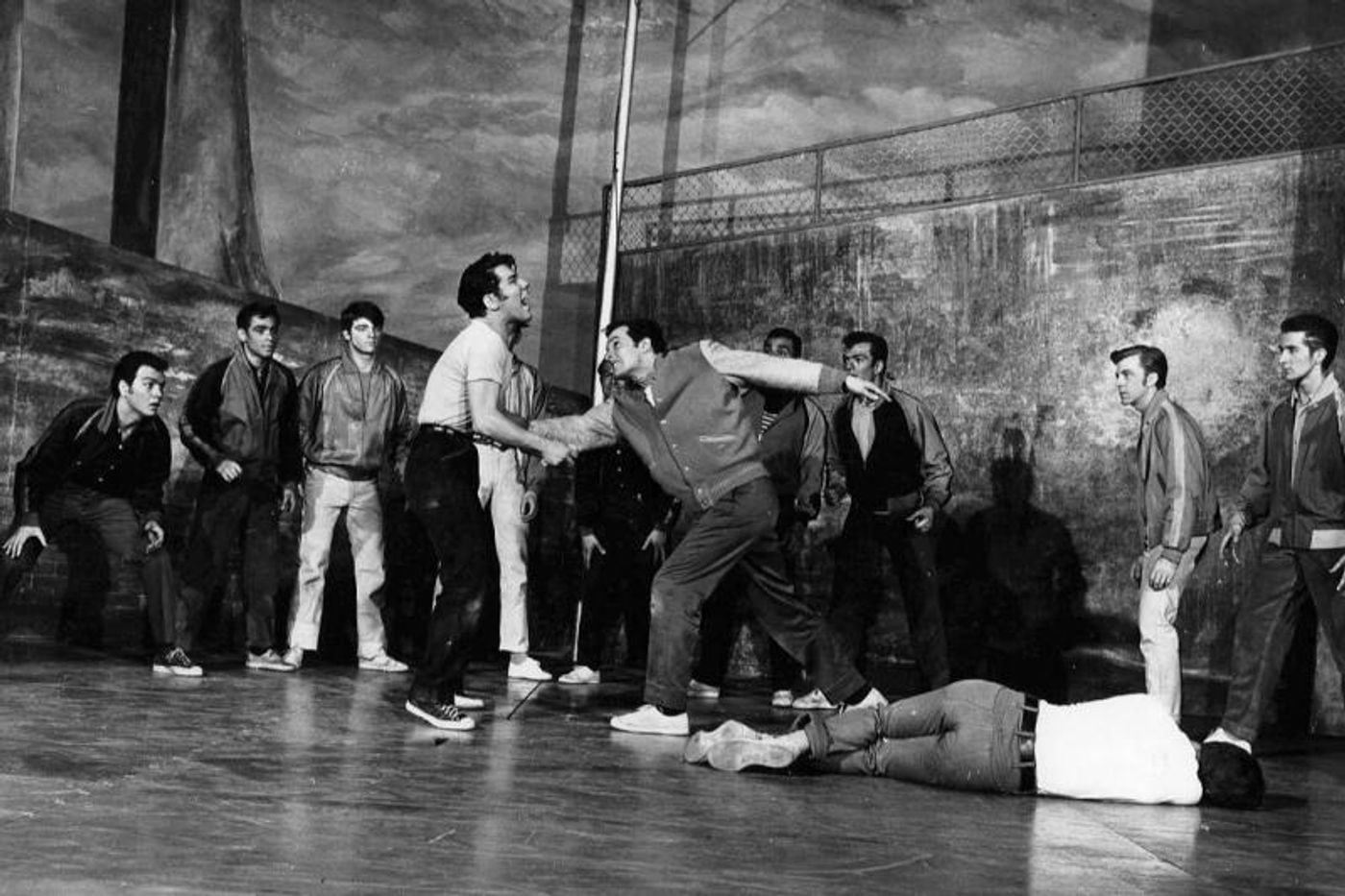 crossed lovers at the play's center were now a Polish boy and Puerto Rican girl named Tony and Maria.
crossed lovers at the play's center were now a Polish boy and Puerto Rican girl named Tony and Maria.
The Bard's ancillary characters also got makeovers with Romeo's right hand man, Mercutio becoming Riff, the leader of the Jets and Juliet's cousin Tybalt becoming Bernardo, Maria's older brother and leader of the Sharks.
Members of the gangs also got character makeovers with Juliet's intended, Paris, becoming the murderous Chino, pacifist Benvolio becoming gentle Jet Baby John, and hotheaded Montague kinsmen, Abraham, transforming into the fiery Action. Prince Escalus served as a composite for the play's two authority figures, Officer Krupke and Lieutenant Shrank.
Friar Laurence and The Nurse got makeovers as well, becoming Doc, Tony's boss and local soda shop owner and Anita, Bernardo's girlfriend and confidant to young Maria. Other characters from Shakespeare's play such as Ladies and Lords Capulet and Montague were omitted altogether, leaving the bulk of the play's focus on the young leading cast.
Of the decision Robbins said, "I went to the territory of the delinquents when I was developing the show- went to their social directors, talked to gang members and leaders, visited their dances and came away with the impression that the kids have a feeling of being born into one of the worst possible worlds. They think they have to live their lives now- without delay. They feel they have to band together to 'own' a piece of a block in a miserable slum area."
He continued, "Alone they are nothing. But together, as a gang, they feel a fantastic sense of security. 'This is our world. You keep out of it. We have the answers. We don't need yours. And the sooner you get that, the sooner you'll dig us!'"
Other changes were made in order to better serve the story of the musical. Romeo & Juliet's famous balcony scene now took place on a dank alley fire escape and the duel became a modern-day rumble fought with pocket knives instead of swords. The team also tweaked the ending with Maria surviving when Tony is murdered by Chino, rather than the Bard's original ending which saw the deaths of both young lovers.
With the updated dynamic between the warring factions in place, Laurents, Bernstein, and Robbins discovered avenues through which they could expound upon relevant themes of the day. In place of the vague rivalry between Shakespeare's  households was now a reality-based conflict through which they could explore racism, gang warfare, law enforcement malfeasance, domestic strife, substance abuse, and the plight of immigrants.
households was now a reality-based conflict through which they could explore racism, gang warfare, law enforcement malfeasance, domestic strife, substance abuse, and the plight of immigrants.
To create the musical world of West Side Story, Bernstein tapped into the personalities of each gang, with the Jets represented by a vocabulary of jazz and be-bop and the Sharks falling into the rich rhythms and orchestrations of Latin music.
As a symphonic composer, Bernstein resolved that the score would not act as a mere backdrop of the action and would include symphonic building blocks that enable the score to tell a story all its own.
One Bernstein feature that would distinguish the music of West Side Story, was his use of tri-tones throughout. Also called 'the devil's interval' or the sharp 4th, tri-tones create an ambiguous sound, an ingenious addition which underscored the hope and danger that make up the show's emotional landscape.
Also embedded in the show's musical language are more subtle features like Bernstein's melding of several musical styles simultaneously. Aside from the warring jazz and Latin rhythms representing the street gangs are layers of additional meaning. For instance, the rhythms in the song "America" are a combination of Mexican Huapango and Venezuelan Joropo, underscoring the universality of Latin America and the American immigrant experience.
Though Bernstein was initially tasked with creating both music and lyrics, the composer was quickly overwhelmed by the task. The team initially approached Betty Comden and Adolph Green to write the show's lyrics, but wound up choosing a twenty-something up and comer named Stephen Sondheim, protege of Oscar Hammerstein II, when the team opted to work on Peter Pan instead.
Sondheim was also hesitant to join the project, as he was looking to break into the business as a composer in his own right, and was at work on his own original musical.
"I didn't want to do it." Sondheim said, "But my surrogate father and mentor was Oscar Hammerstein. I went to him for advice and he said, 'I think you should do it. Though what you want to do is write music, this is the chance to work with real professionals. I think it would be a very, very good experience for you.' I said okay, and that's how I got the job."
"I learned a lot from Lenny, just by listening and seeing how he approached writing. He never lectured me," he continues, "He was very fond of changing my lyrics. I would write something, he would change it, and we would argue. I was 25 years old and he treated me like a kid. He treated me very nice and very well, but that condescension was always there. It took a long time before he accepted the fact that I was my own man."
Bernstein also gained a thing or two from working with the young lyricist. One day, Laurents suggested that the song for the balcony scene, "One Hand, One Heart" (previously composed for Bernstein's operetta, Candide) was lacking the excitement and sensuality that would exist between budding young lovers. As a solution, Sondheim pointed to the couple's melody in "Quintet" as the basis for a new song. On Steve's suggestion, Bernstein fleshed out the theme into the now-famous fire escape duet, "Tonight." Sondheim also condensed large swaths of text into lyrics using lines like, "A boy like that would kill your brother" as the basis for new songs.
Not all of Sondheim's lyrics were well-received upon the show's debut, however, as some of the work was criticized for perpetuating Latin stereotypes. The "America" lyric, "island of tropic diseases" nearly drew protesters for its insinuation of Puerto Ricans as carriers of disease. Despite the criticism, the line remained.
Another roadblock in the creation of the piece involved the use, or lack thereof, of profanity among the street kids. Since the use of four-letter words was strongly cautioned as it would undercut record sales and offend delicate sensibilities, Sondheim and specifically Laurents, gave birth to their own slang style (i.e. 'cut the frabba jabba') to avoid dating the show in future productions.
At last, casting began and the team assembled the group of actors that would bring 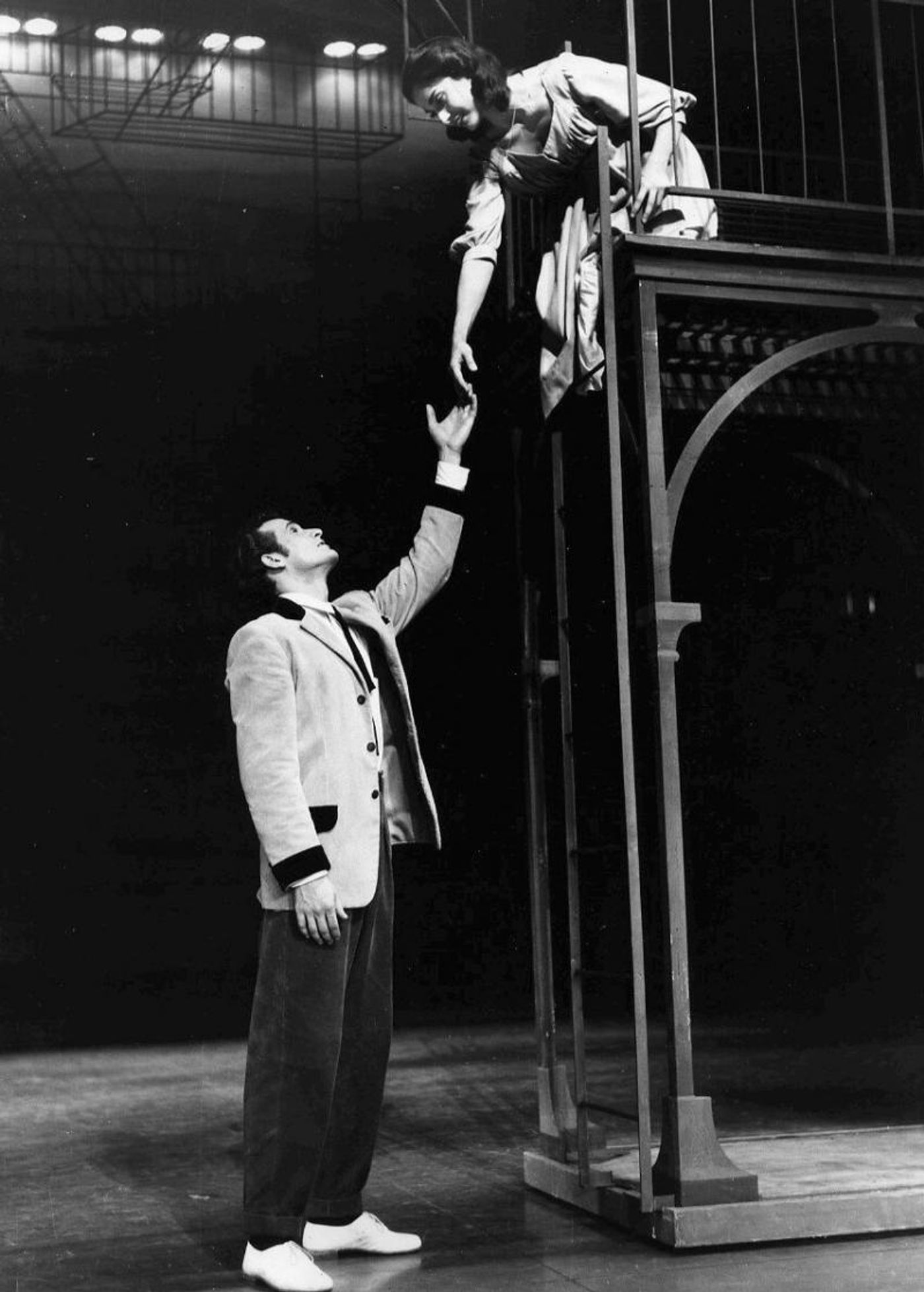 West Side Story to the world. Though Arthur Laurents initially envisioned James Dean as Tony, Larry Kert would ultimately land the role after being turned down for three other parts. Kert was paired with Maria hopeful, Carol Lawrence, on her thirteenth audition.
West Side Story to the world. Though Arthur Laurents initially envisioned James Dean as Tony, Larry Kert would ultimately land the role after being turned down for three other parts. Kert was paired with Maria hopeful, Carol Lawrence, on her thirteenth audition.
Of the audition, she recalled, "Jerry Robbins said, 'I'm going to have him sing 'Maria', but I want you to hide somewhere on the stage. And if he finds you, do the balcony scene.' There was no where to hide in the theatre, but on the wall there was a little grating of iron. I didn't even know if it would hold me, but I climbed it and knelt down in the fetal position. So he was singing and looking and I was nowhere to be found. And so finally, I whispered 'Tony, Tony' and he turned and became Spider-Man. He climbed that wall and we did the entire balcony scene not even knowing if the thing would hold us. And the scene ended and they stood up and applauded, Jerome Robbins applauded."
Larry Kert adds, "Leonard Bernstein comes down and says, 'I don't know what's going to happen, but that's the most mesmerizing audition I've ever seen.'"
"And they said, 'You've got it.'" Lawrence remembers, "And that's when I really burst into tears, I couldn't believe it."
As rehearsals began, buzz built around town of the ambitious and dark new work. Not all of the gossip was good, however, as West Side Story was set to open against an array of sunny, escapist musicals like My Fair Lady, Guys and Dolls, and The Music Man. With it's dark subject matter, cast of unknowns, fight scenes, attempted rape and three onstage murders, the show presented a risky proposition. So risky, in fact, that six weeks before rehearsals were set to begin, lead producer Cheryl Crawford dropped the project when the backers audition failed to raise money.
The loss of Crawford dealt a hard blow to the show, prompting Sondheim to contact his friend, a young producer named Hal Prince. Upon meeting with the team, Prince immediately saw potential in the project and agreed to pick up where Crawford had left off, despite advice to turn it down from friend George Abbott.
In later years, the world would discover a similar pattern with Hal as he produced and directed some of the most progressive musicals in history- where others saw a risk, Hal saw the future.
Rehearsals for the show began on June 24, 1957 with a cast including including Carol  Lawrence and Larry Kert as Tony and Maria, Mickey Calin as Riff, Ken Le Roy as Bernardo, and Chita Rivera as Anita.
Lawrence and Larry Kert as Tony and Maria, Mickey Calin as Riff, Ken Le Roy as Bernardo, and Chita Rivera as Anita.
On the first day of rehearsal, Robbins posted an article about a gang killing in the studio, scrawling above it, "Read this; this is your life."
Arthur Laurents spoke of the tumultuous rehearsal process, saying, "So many people who I spoke with described the production itself as a gang war."
"Jerry had declared that first day that the stage was a battleground," added Carol Lawrence, "You were never allowed to walk on that stage except at his request; he was an absolute dictator."
"He brought this Method-acting technique into the show," she continues, "where he deliberately tried to foment animosity and antagonism between the two opposing gangs, both on stage and off stage. They weren't allowed to eat together. They were not supposed to socialize."
Hal Prince agreed to double the dance rehearsal period at Robbins' request and he began work on what would become some of the most iconic choreography in musical theatre history. Robbins' background in ballet would serve as the basis for his character-based movements which treated dancers as actors inhabiting roles, rather than moving bodies.
For instance, the Jets' famous "sailing step" with outstretched arms and open palms symbolizes owning the street, characterizing white privilege and the ability to take up space with impunity. When the Sharks later mimic this motion, it is only used briefly before the dancers close into tight turns, fists outstretched, symbolizing their wish to enjoy the freedoms of their white counterparts and awareness of danger from every angle.
The show's Anita, Chita Rivera, was one of the cast members who was put through her paces by Robbins,
 She says, "I called him Big Daddy. As a dancer, it's not easy to do what we do. And if we didn't have that teacher, that one teacher, who scared the heck out of us, where would we be? We wouldn't have tried it. All of that makes you who you are."
She says, "I called him Big Daddy. As a dancer, it's not easy to do what we do. And if we didn't have that teacher, that one teacher, who scared the heck out of us, where would we be? We wouldn't have tried it. All of that makes you who you are."
Robbins imposing presence and confrontational style also extended to his fellow creatives.
Sondheim recalls, "I'm sitting in the darkened theatre with Lenny and the orchestra starts playing. Jerry goes down the aisle, stops them, and begins to reduce the orchestra. I thought, 'I can't believe it. He's changing Lenny's orchestration.' Jerry had no right to do that. I looked over to see what Lenny's reaction was and he was gone. It was an empty chair...Lenny just hated confrontation and Jerry knew that. One of the parts of Jerry's genius was he could size you up immediately when he met you and know what you were most afraid of."
As the process continued, Bernstein's score drew much criticism from his fellow creatives. The team characterized much of his work as being too operatic. He bemoaned this dynamic in letters to his wife, declaring, "This is the last show I do."
After years in development, countless auditions, skirmishes among the creative team, and a last-minute change of producer, .jpg?format=auto&width=1400) West Side Story was finally ready for its world premiere, and held out of town tryouts in Philadelphia and Washington D.C..
West Side Story was finally ready for its world premiere, and held out of town tryouts in Philadelphia and Washington D.C..
Original Maria, Carol Lawrence, describes the first ever curtain call, "We all ran to the footlights for the bow, and the curtain went up and there was not a sound. And I thought, 'It's a flop! They were right!'"
She continues, "And then, as if Jerry Robbins choreographed it, they leaped to their feet! They began screaming, they began applauding, they began stomping their feet! I had never heard anything like that before and I began to cry. Seventeen curtain calls later, Leonard Bernstein walked on from the wings, into my arms, and we just sobbed. We sobbed because the audience took it to their hearts. And they said, 'Yes! We believe you and we love you."
The original Broadway production ran just 732 performances at Broadway's Winter  Garden Theatre. It took home two 1958 Tony Awards for Jerome Robbins' choreography and Oliver Smith's scenic design, but lost Best Musical to Meredith Willson's The Music Man. Also nominated were Carol Lawrence as Best Actress in a Supporting Role in a Musical, Max Goberman as Best Musical Director and Conductor, and Irene Sharaff for Best Costume Design.
Garden Theatre. It took home two 1958 Tony Awards for Jerome Robbins' choreography and Oliver Smith's scenic design, but lost Best Musical to Meredith Willson's The Music Man. Also nominated were Carol Lawrence as Best Actress in a Supporting Role in a Musical, Max Goberman as Best Musical Director and Conductor, and Irene Sharaff for Best Costume Design.
Following the show's Broadway success, a national tour was launched, along with a repeat visit to Broadway. It would later go on to a a hit stint on London's West End, as well as tours of Europe and Israel. Thanks to its worldwide critical and box office success, the next and most notable chapter in the saga of West Side Story would begin shortly thereafter.
In the spring of 1960, production began on the film adaptation of West Side Story.
The studio had selected veteran film director, Robert Wise, to helm and produce the project. Selected for his prowess directing both drama and musical films, Wise was the ideal candidate. At the studio's urging, however, Wise agreed to bring Jerome Robbins aboard as co-director and choreographer to help shepherd the material to the big screen. Despite his trepidation, Wise concluded that Robbins' creative input was crucial to the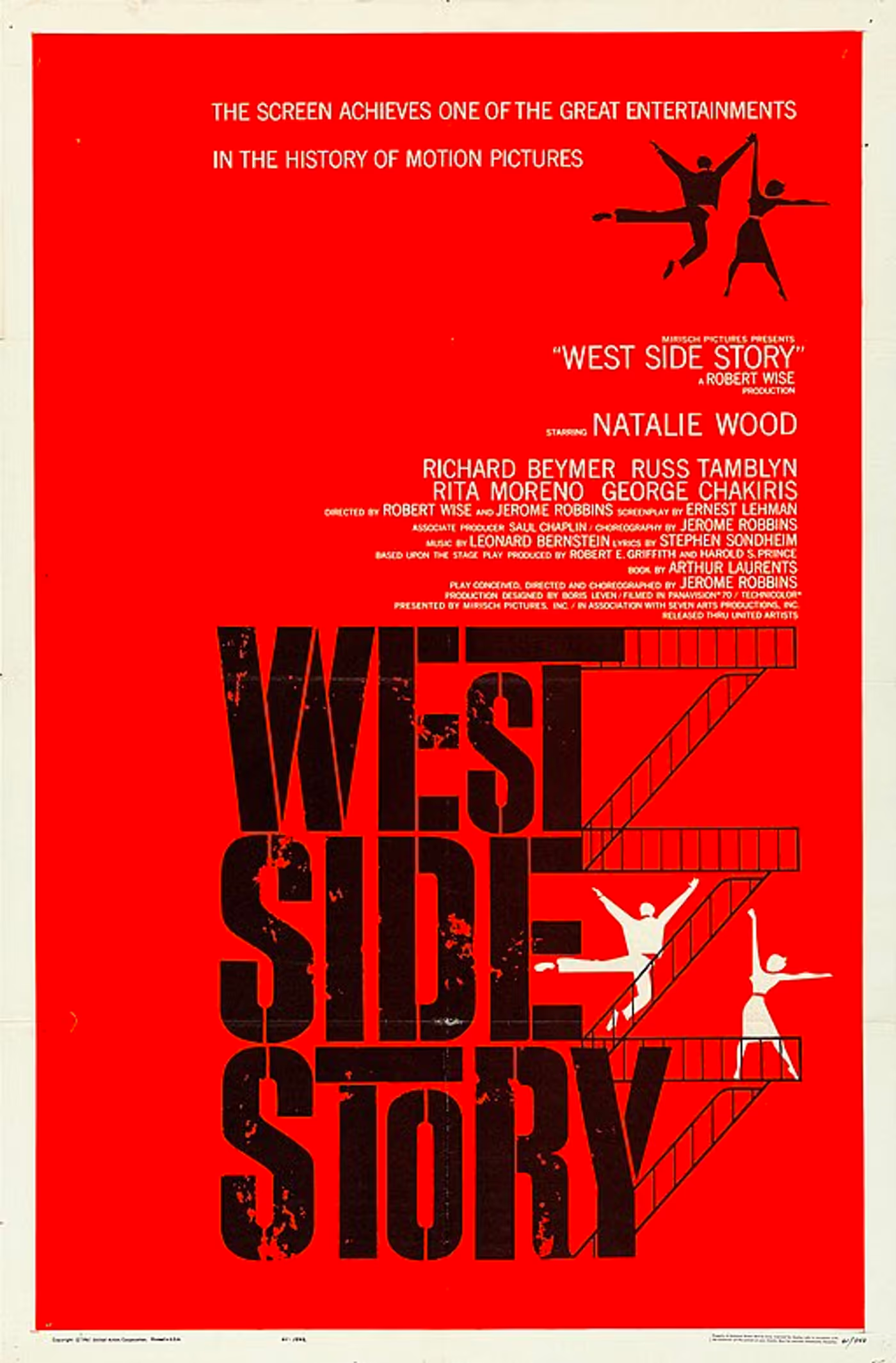 film's success.
film's success.
Mirsch Pictures Inc. allocated $6,000,000 for the making of the film. To bring the story to life on the big screen in the best possible fashion, the team required an extensive amount of time to not only adapt the play, but to search for the most ideal locations, to design and build sets, and to scour the world for the best possible actor-dancers to fill out the 26-person ensemble and all-important leading roles.
The team conducted months of auditions and screen tests in New York, Hollywood, and London in search of their stars. The search was so extensive that what felt like every dancer in the world was vying for a spot on the much-coveted project. Competition was so steep, in fact, dancer Maria Jimenez Henley arrived to the first rehearsal the day after undergoing an emergency appendectomy. She only left to have her wound re-stitched when a fellow dancer noticed blood on the studio floor.
After much searching, the company was set. Bringing the musical's leads to life on the big screen would be movie stars Natalie Wood and Russ Tamblyn as Maria and Riff, a former West End Riff, George Chakiris as Bernardo, Richard Beymer as Tony and Rita Moreno as Anita.
Moreno was just a child when she immigrated from Puerto Rico to New York City with her mother. She recalls her firsthand experiences living through the events of the story:
"Coming to America was an enormous shock, because it was freezing cold. It was February. And it was not a happy welcome. People didn't like us very much. My earliest experiences were of young people calling me 'spic', which is a horrific word. And I couldn't understand why. What was I doing that made these young people so angry at me?"
Of the role she said, "I knew Anita. I knew it the minute I saw the script and the audition. I knew who this girl was- she was me. It was the first time I had played a .jpg?format=auto&width=1400) Hispanic girl who had a sense of self, who had a sense of dignity, there was nobody like me."
Hispanic girl who had a sense of self, who had a sense of dignity, there was nobody like me."
One aspect of the adaptation that has not aged well despite its legacy as one of the greatest films of all-time was the decision to cast white actors as Puerto Rican characters. As one of the only true Latinos on the set, Moreno discussed this decision in later years.
"The reason was that there simply weren't enough Hispanic male and female dancers at the time who could do the kind of professional job that was needed for Jerome Robbins choreography. There just weren't any," she continues, "The reason was, I'm surmising, is that a lot of Latino kids in those days didn't have the money to take those kinds of classes. There were many who had talent, but didn't have the training. So as a result, there were just a few of us who were truly Latino who were able to get the part."
The film's use of brownface and over the top accents were also a point of contention for Moreno throughout filming.
"They made me use an accent, which I wasn't crazy about, because a lot of us obviously do not have them. The thing that really bothered me the most was that they put the same muddy, brown makeup on every Shark girl and boy. I tried to get that changed. I said, 'Look, some of us are very white, some of us are olive-skinned, some of us actually have black blood, some of us are Taino-Indian.' Nobody paid attention. I wasn't very happy."
The cast would spend five summer weeks dancing through the streets of the New York City under the exacting eye of Robbins, who significantly increased both the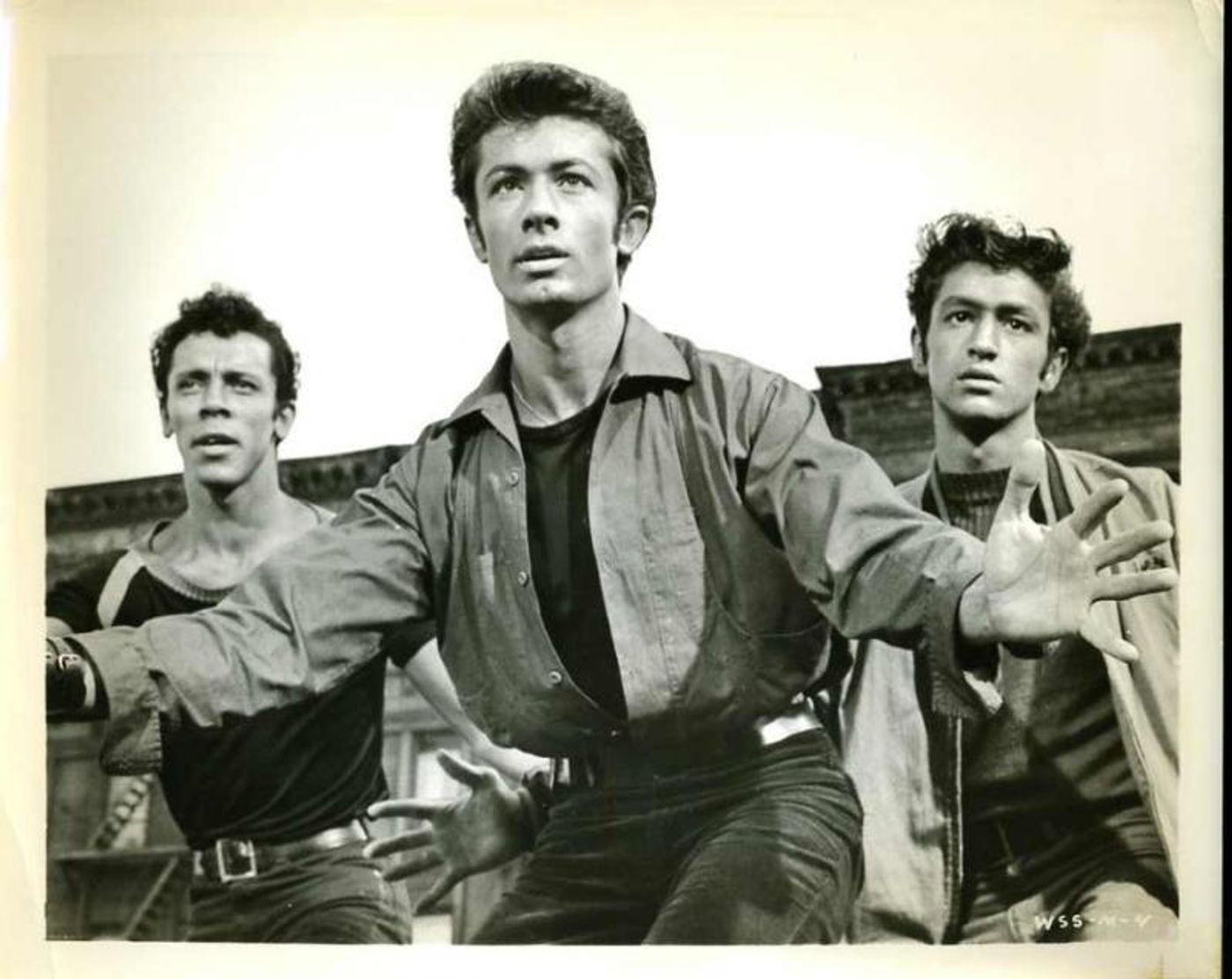 schedule and budget with his demands for absolute perfection.
schedule and budget with his demands for absolute perfection.
Russ Tamblyn recalls the particularly grueling process of shooting the film's Prologue:
"[Robbins] was never quite satisfied. I remember one incident where we danced for maybe two blocks down a street. We did this whole long number to the end of the block. They yelled 'Cut' and Robert Wise said, 'That was great for me' and Jerry said, 'That was fine for me, too. But I would like to do one more, but this time I would like all of you to do it on the other foot.'"
Aside from Robbins technical demands, the cast also battled the shooting conditions. Dancing for hours on hot pavement, many of the dancers developed shin splints and other conditions over the course of filming. The filming of the "Cool" sequence was so grueling, the Jet dancers burned their knee pads in a pile in front of Robbins' office door when it wrapped.
Another scene in the film that proved particularly difficult was the Jets' attempted rape of Anita in the candy shop. Despite the extensive preparations Robbins had taken to choreograph the sequence, the scene proved triggering for Rita Moreno, who experienced a severe emotional breakdown during filming.
"Having the boys constantly cursing me out and throwing me around and calling me things like 'Spic' and 'Garlic Mouth' and 'Pierced Ear' apparently opened up some wounds that I thought had healed years and years before," she continues, "In the middle of shooting that scene, I stopped, sat down at the candy counter, put my head on my arms, and started to sob. I could not stop. I was inconsolable. And the boys came to me and said, 'Oh Rita, you know we love you. Please don't cry' and begged me to stop and I just couldn't. There is a huge piece of my soul in that scene."
She adds, "By the time we got to the part where I go to the door and say, 'Don't you touch me.' Wow. That was filled with every terrible anger I had ever experienced in my life."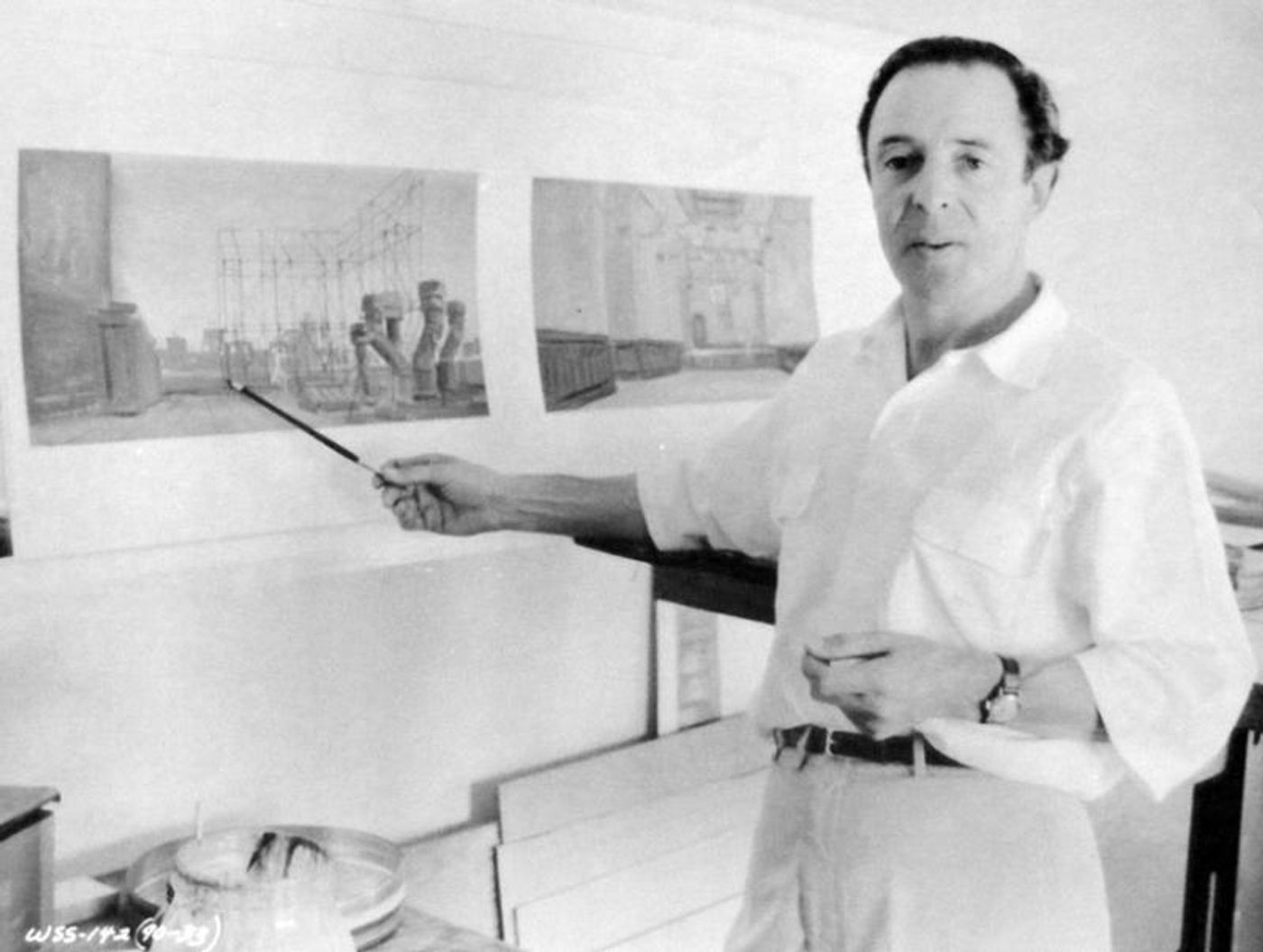
Despite the extraordinary results his exacting approach achieved, Robbins' working style was not conducive to the time and monetary constraints of film making, and he was eventually asked to leave the production. Despite his intensity and imposing presence, his departure left the cast heartbroken.
Some changes were made to the narrative to better suit film audiences. "Gee, Officer Krupke" formerly sung by Action in Act 2 to give Broadway audiences a moment of levity among tragedy, would now take place in Act 1, sung by Riff. This made way for "Cool" to move to the film's second half, now a vehicle for the Jets to vent their post-Rumble grief and anxiety.
This change satisfied Stephen Sondheim, in particular, who had lobbied for the switch throughout the show's creation. He never felt it believable that grieving, rageful teenagers would sing such a comic number after witnessing two murders.
Another significant and successful change was the addition of the the Sharks to the number "America". Performed onstage by only the Puerto Rican female ensemble and Anita, the addition of the hardened male 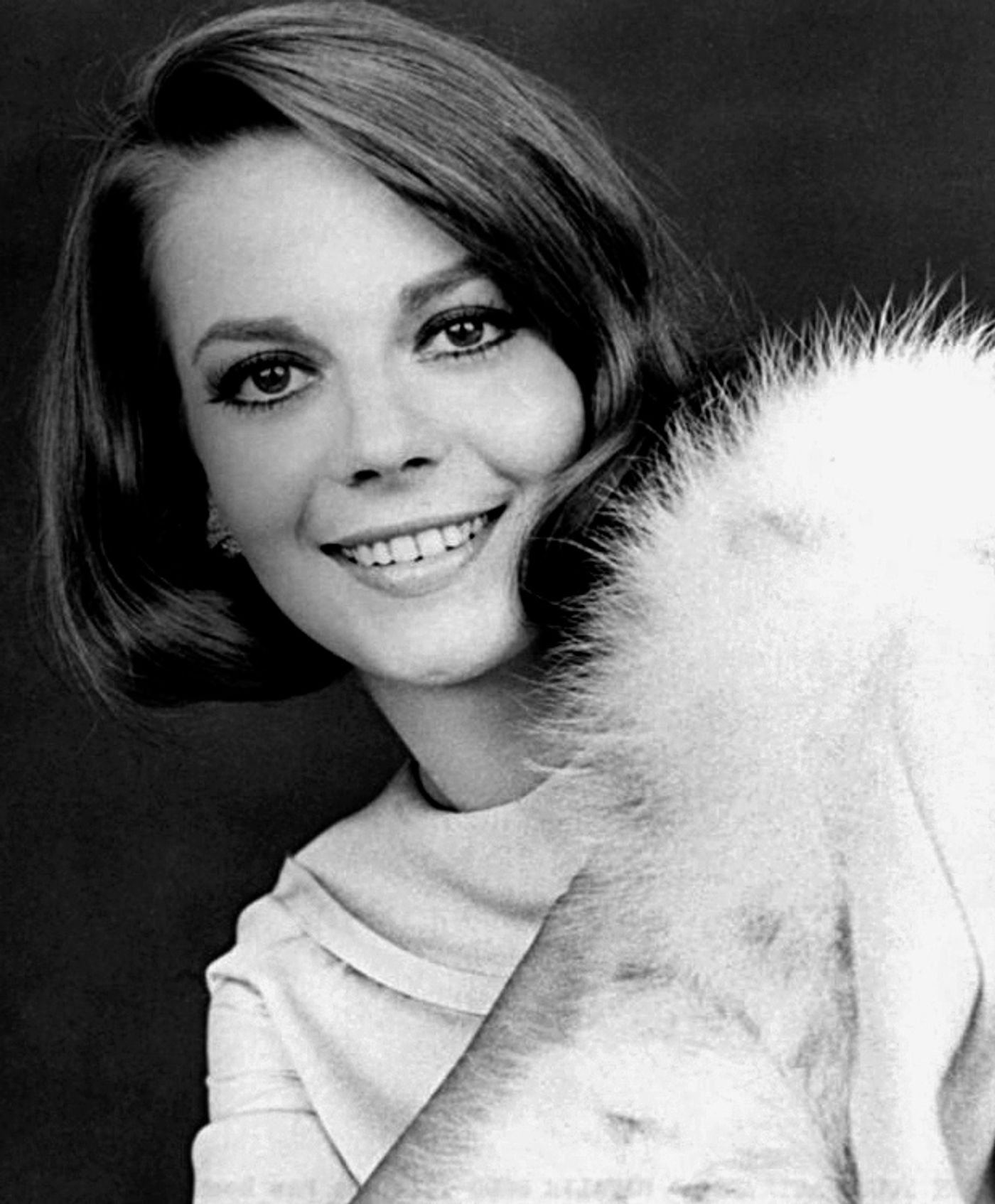 perspective provided a counter-balance to the female optimism of their new homeland. These changes also created an opportunity to update some of the formerly offensive lyrics and showcase the talented male ensemble.
perspective provided a counter-balance to the female optimism of their new homeland. These changes also created an opportunity to update some of the formerly offensive lyrics and showcase the talented male ensemble.
Tony and Maria's duet "Tonight" was moved to follow "America." The song "Somewhere" formerly performed by an offstage voice while the two gangs danced a harmonious dream ballet would now act as a duet between Tony and Maria, one last gasp of hope for the young lovers torn apart by hatred.
Other slight changes were made such as lyric updates in several songs. The choral finale of "Somewhere" was cut in favor of leaving the film on a more somber note, with an instrumental version of the song now underscoring the end credits.
Russ Tamblyn's portrayal of Riff would also affect future portrayals of the character. When the actor, famous for his gymnastic abilities, was cast, Robbins informed him that no acrobatics would be used in the film. After Robbins was dismissed from the set, an associate choreographer encouraged Tamblyn to add some flips to his dance sequences. Years later, the actor would attend a production of Jerome Robbins' Broadway in which the dancer playing Riff did a back flip during "Dance at the Gym". When Tamblyn told the dancer of Robbins' strict 'no gymnastics' rule, the dancer informed him that Jerry Robbins had him do it as part of his audition. The flip remains part of Robbins' choreography to this day.
According to statistics from the shoot, the cast wore out 200 pairs of dancing shoes, sweat off 100 pounds of makeup applied by eight makeup artists, male dancers split 27 pairs of pants (including lead George Chakiris who was forced to wear black tights beneath his 'Mambo' suit after splitting all available options), over 18,000 band-aids were dispensed for various injuries, thirty recording sessions utilized 300 musicians, and lastly assistant director, Robert Relyea, called "Quiet" on the set 3,985 times- and got it 2,678 times.
The film was praised by both critics and the public, and became the second-highest-grossing film of the year in the United States. It won ten Academy Awards out of eleven nominations, including Best Picture, making it the most decorated musical film in history. Rita Moreno became the first Latino actress ever to win an Oscar. The soundtrack went on to win a Grammy Award and was ranked No. 1 on the Billboard chart for a record 54 weeks. Ultimately it grossed $44.1 million worldwide, which works out to $370 million in modern grosses, 7.3 times the film's budget.
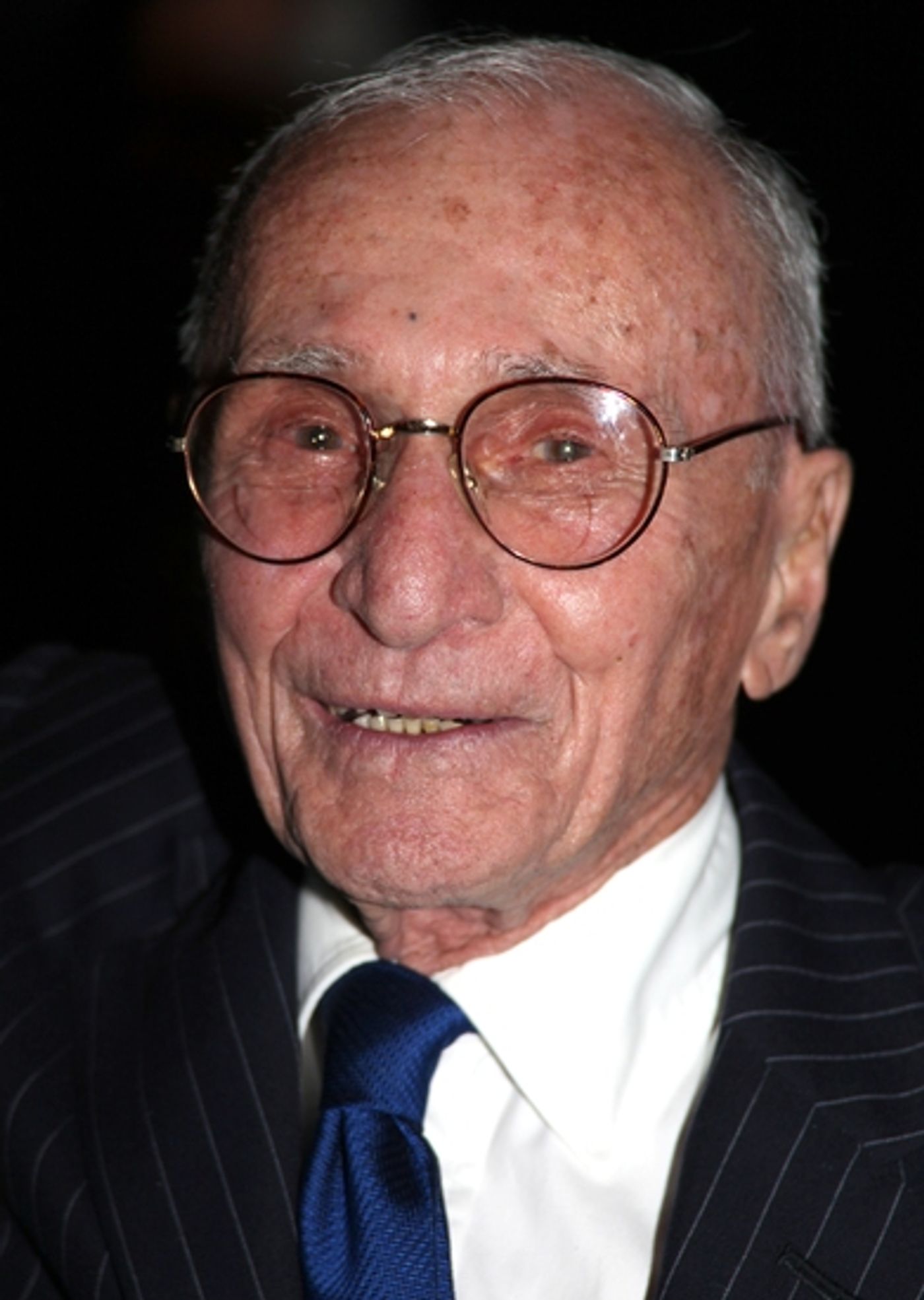 After the rollicking success of the film adaptation, West Side Story returned to New York for a brief one month run at City Center in 1964. The musical would not reappear on the Broadway stage, however, until 1980, when it was revived at the Minskoff Theatre, featuring Debbi Allen as Anita.
After the rollicking success of the film adaptation, West Side Story returned to New York for a brief one month run at City Center in 1964. The musical would not reappear on the Broadway stage, however, until 1980, when it was revived at the Minskoff Theatre, featuring Debbi Allen as Anita.
West Side Story would not receive another major update for nearly 30 years after the 1980 revival closed, when a new production was planned for 2009, helmed by the show's book writer, Arthur Laurents.
At an incredible 91-years old, Laurents had decided to not only revive the show, but to revise it as well. skewing the storytelling in a way that would highlight the show's story more than its telling.
"The original was really about how you tell the story," he explained to the New York Times in 2009, highlighting the original production's focus on the integration of dance, music and book. This version, Laurents explained, would focus on "the story of Tony and Maria and love."
Another element critical to the show's revision, was the decision to integrate Spanish into the Sharks' dialogue and lyrics.
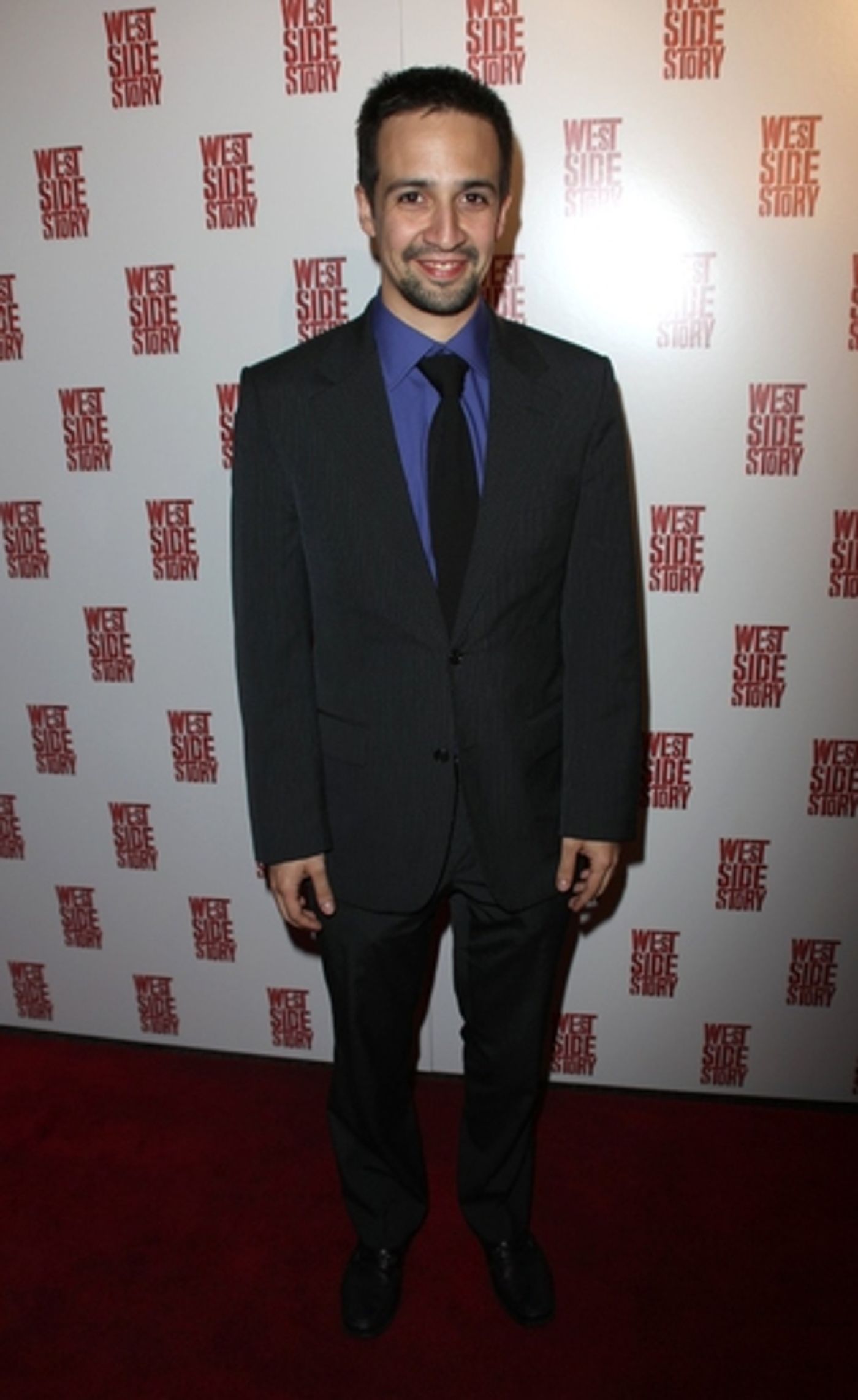
"It gives the Sharks infinitely more weight than they've ever had," Mr. Laurents said.
This invention would require the bilingual gifts of a relative newcomer to the Broadway community. Lin-Manuel Miranda. Fresh off Tony wins for his hit ode to Latin identity, In the Heights, Miranda was selected by producer Kevin McCollum to give Laurents' book and Stephen Sondheim's lyrics their Spanish makeover.
"It was the hardest bilingual crossword puzzle I've ever done," Miranda, then 29, told the New York Times.
There were a number of challenges in adapting the work to its new tongue, namely the difficulty of keeping the wit and meaning of Sondheim's lyrics intact, while also presenting a form of Spanish natural to the tongues of native speakers.
"It can't be high school Spanish," Laurents insisted.
Having grappled with bilingual elements of In the Heights, Miranda worked closely with the team to adapt the work and was given a fairly long tether to do so.
In the case of, "I Feel Pretty", a song Sondheim had never been particularly fond of, Miranda was given license to adapt the song using whatever imagery made the most sense to the new translation.
Sondheim told The New York Times, "The idea of the song is so simple...I was only 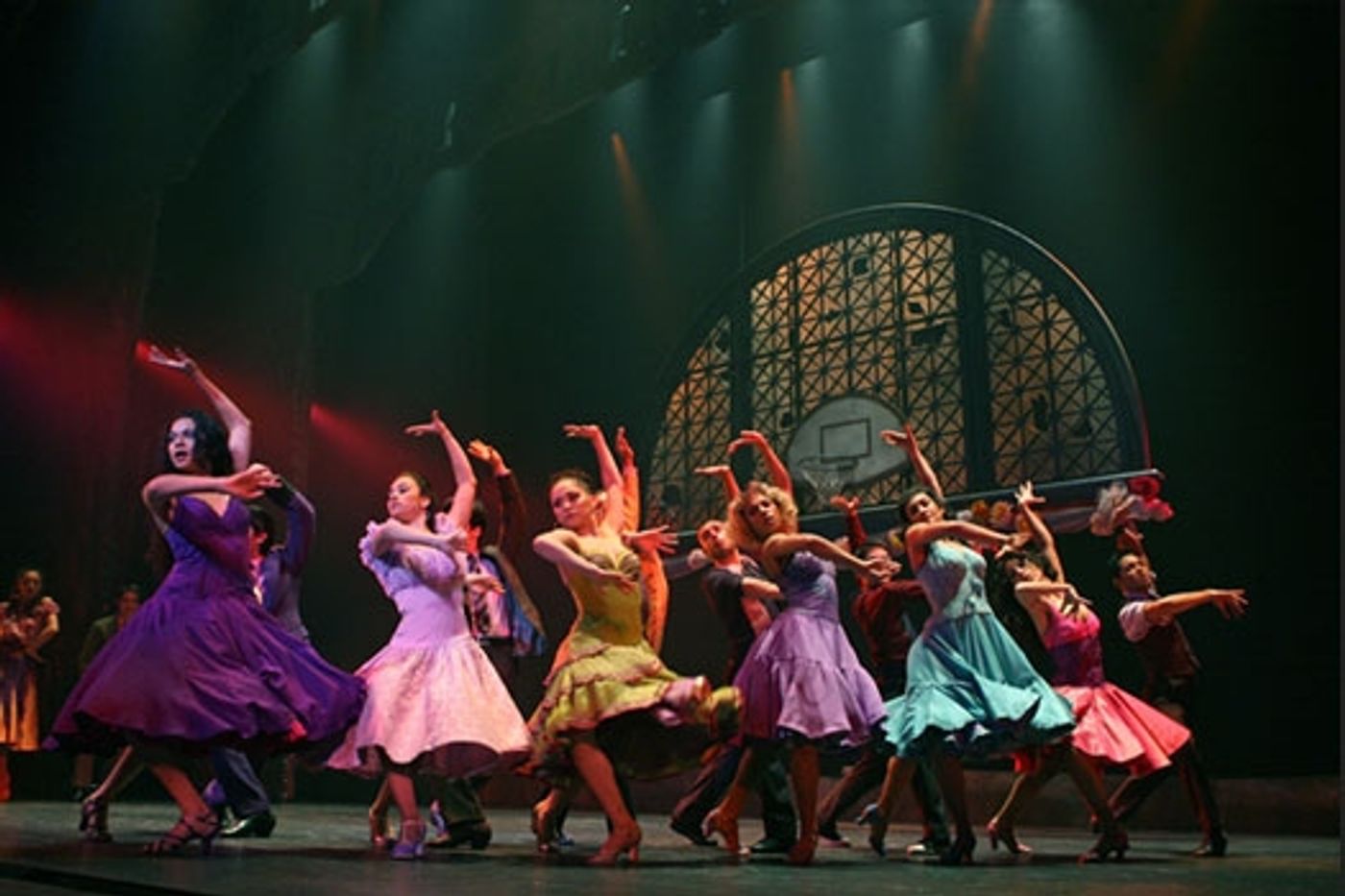 concerned that Lin observe the rhyme schemes."
concerned that Lin observe the rhyme schemes."
The book also required a number of updates. Using the South American translations as a jumping off point, Lin worked to tone down the high-brow vernacular to the language of the streets.
To assist in the translation, Lin enlisted his father, Luis Miranda, a Puerto Rican immigrant who had arrived in America during the show's time period. To work on the material, Lin returned to his childhood home, holing up there for months to strike the most accurate balance possible between Latin authenticity and preserving authorial intent.
"Stephen Sondheim and Luis Miranda are the two tent poles I'm trying to satisfy." Lin said.
As a result of this work, the dialogue between the Shark girls and boys would now take place almost exclusively in Spanish. In its new translation, "I Feel Pretty" took on the new title, "Siento Hermosa" and Anita's admonishing number, "A Boy Like That" would now go by "Un Hombre Asi."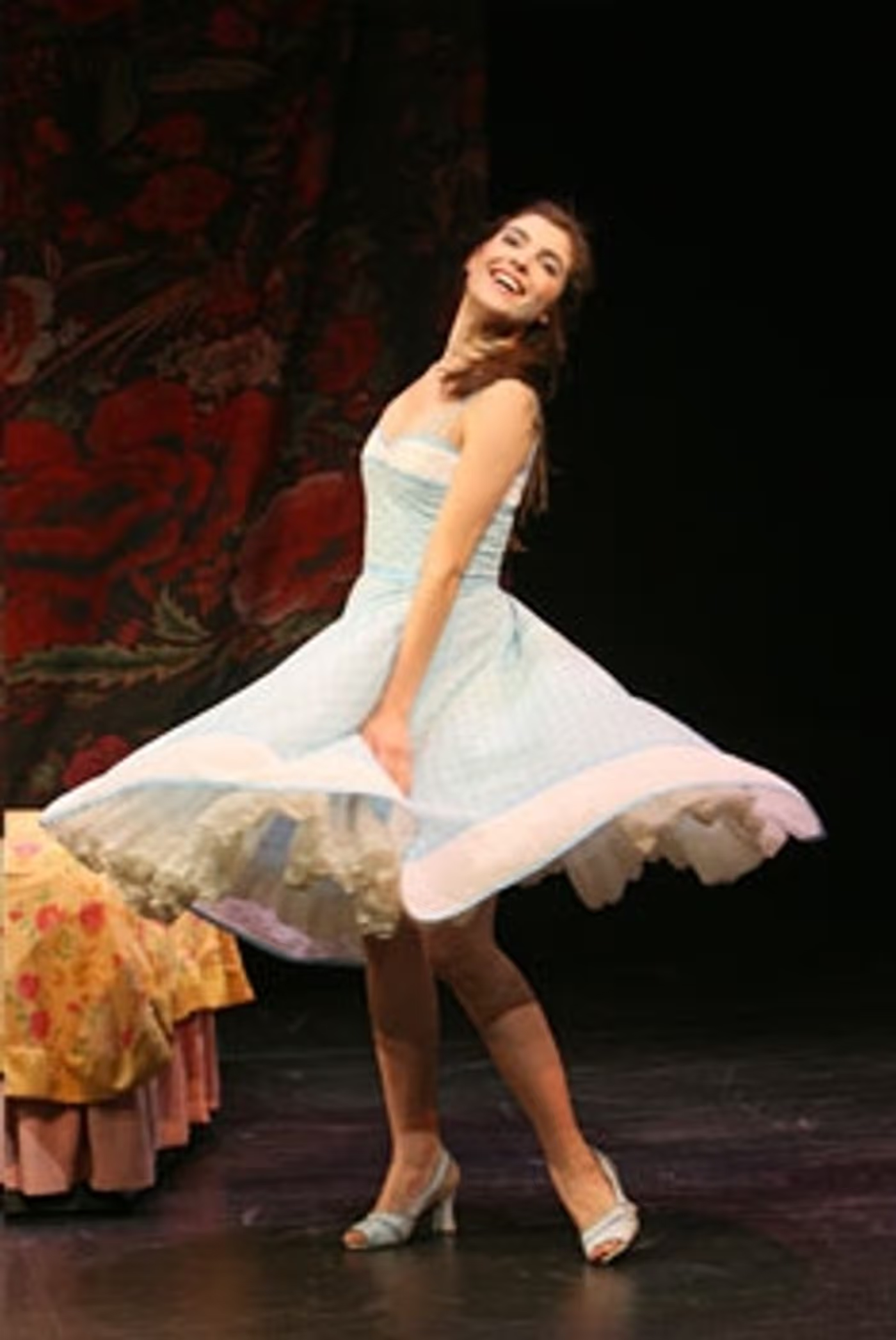
Other changes would be in store for the show, including Laurents' absolutely necessary insistence that all the Latino characters be played by Latinos, righting a longstanding wrong among earlier high-profile productions.
Another change made for the sake of realism was the exclusion of the Sharks assisting the Jets in carrying Tony's lifeless body offstage at show's end. Laurents felt it was entirely unrealistic for law enforcement to allow tampering with the crime scene.
Not included in the move to authenticity were the costumes, which costume designer, David Woolard, updated with somewhat anachronistic silhouettes and styles, punctuated by flashes of each gangs signature color. In this production, the Jets would be symbolized by orange and the Sharks outfitted in purple.
This change was inspired when the team read about a gang fight in Nyack, NY, which was sparked when a gang member's girlfriend had her colored bandanna yanked off by a member of a rival gang.
"We started out with costumes, and we ended up with clothes," said Mr. Laurents.
Other changes were made to update the show, mainly having to do with the level of savagery depicted on stage. Upon its debut in 1957, the show was praised for its groundbreaking depictions of violence and hatred. Later productions, however, were criticized for what critics interpreted as a waning relevance
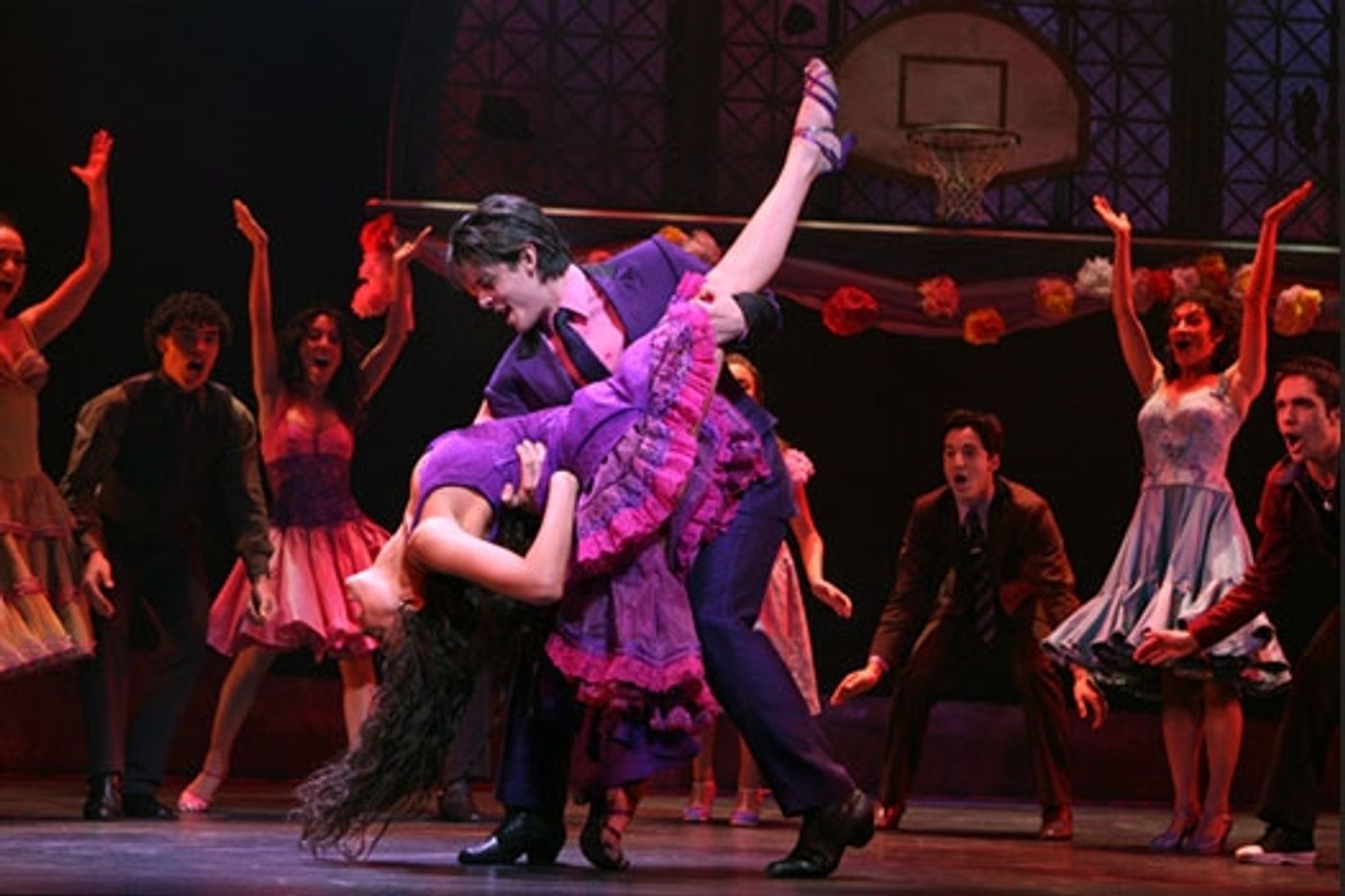 In 1968, William Kloman wrote of the show that "events have outrun its message." Frank Rich echoed similar sentiments of the 1980 revival, writing, "the sociology and liberal faith of Arthur Laurents' book are now fairly meaningless," and that audiences "no longer feel ghetto tragedies can be overcome by pleas for tolerance and understanding."
In 1968, William Kloman wrote of the show that "events have outrun its message." Frank Rich echoed similar sentiments of the 1980 revival, writing, "the sociology and liberal faith of Arthur Laurents' book are now fairly meaningless," and that audiences "no longer feel ghetto tragedies can be overcome by pleas for tolerance and understanding."
To remedy this, Laurents and his team made a point of scaling up the level of grit in the production, axing some of the more comic aspects of "Jet Song" and "Officer Krupke" and upping the graphic nature of the attempted rape of Anita.
After much preparation, the production began out of town previews in Washington. The bilingual elements required some tinkering as non-Spanish speaking audiences found it somewhat difficult to follow. Supertitles were added briefly before being dropped entirely. The team eventually settled on a strategic balance of English and Spanish that ultimately mollified the issue.
The changes were well-received out of town with Peter Marks writing that the use of Spanish provided "a truer sense of the cultural misunderstandings at the heart of  West Side Story as expressed in the characters' disparate languages."
West Side Story as expressed in the characters' disparate languages."
The production opened on Broadway at the Palace Theatre in February 2009 to mostly favorable reviews. The cast featured Matt Cavenaugh as Tony, Josefina Scaglione as Maria and Karen Olivo as Anita.
The production ran through 2011, making it the longest running Broadway production of the show so far. Some of the Spanish elements in "Siento Hermosa" and "Un Hombre Asi" were reverted back to English part way through the run. Orchestra size was also shrunk to cut costs, with five players being replaced by synthesizers. Overall, the production was considered a financial success and was awarded the Grammy Award for Best Musical Show Album. Karen Olivo won the 2009 Tony Award for Best Featured Actress in a Musical for her portrayal of Anita.
In 2018, it was announced that a new revival of West Side Story was headed to Broadway. This production, helmed by experimental theatre auteur, Ivo van Hove, promised to be the most innovative yet.
The news proved controversial from the get go, however, when it was revealed that the .jpg?format=auto&width=1400) production would eschew Jerome Robbins' choreography in favor of a more modern style, provided by contemporary dance choreographer, Anne Teresa de Keersmaeker.
production would eschew Jerome Robbins' choreography in favor of a more modern style, provided by contemporary dance choreographer, Anne Teresa de Keersmaeker.
The production would also deviate from the traditional cast makeup of white Jets versus Puerto Rican Sharks, favoring a more diverse ensemble which would more closely mirror the ethnic melting pot of the modern day. The team began its search for actors and dancers of all ethnicities in November 2018, and announced its company the following July.
Leading the cast of this new West Side Story would be Once on This Island star, Isaac Powell as Tony, The Lion King alumni Shereen Pimentel as Maria, Yesenia Ayala as Anita, and Amar Ramasar as Bernardo. Ben Cook, who was initially cast as Riff would eventually leave the production due to a shoulder injury. He was replaced in the role by Dharon E. Jones.
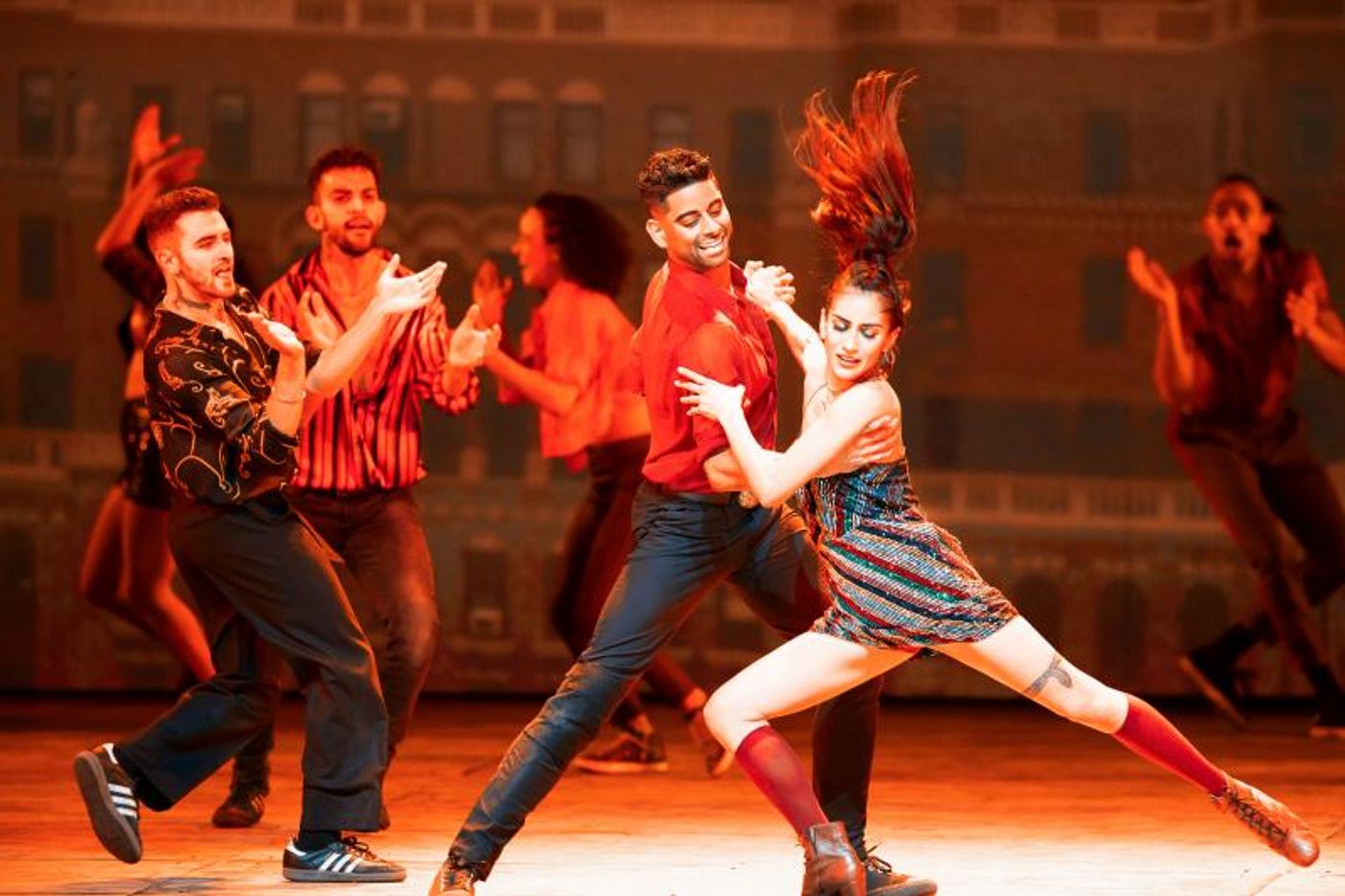 More significant changes to the show caused much pearl-clutching among purists as it was announced that the revival would shave the show's run time down to a brisk 95-minutes and cut the beloved number, "I Feel Pretty" as well as the "Somewhere Ballet." In addition, Van Hove announced that he would use the unisex version of "America" from the film, rather than the stage version performed by Anita and the Shark girls.
More significant changes to the show caused much pearl-clutching among purists as it was announced that the revival would shave the show's run time down to a brisk 95-minutes and cut the beloved number, "I Feel Pretty" as well as the "Somewhere Ballet." In addition, Van Hove announced that he would use the unisex version of "America" from the film, rather than the stage version performed by Anita and the Shark girls.
"The goal and challenge of the new approach," Van Hove said would be to, "seduce [audiences] to follow our way of telling this story" adding, "I want to make a juggernaut. You feel that these people are running toward their death and there's no escape from it."
To aid in the creation of his juggernaut, Van Hove would use video imagery, a signature tactic previously deployed in his Tony-nominated production of the media satire, Network. The team would project the onstage action onto a massive black back wall, filmed by handheld cameras onstage, as well as 25  additional cameras positioned throughout the space. They also created a number of secret sets throughout the theater, where fully filmed scenes would be shot and projected onstage. Other video elements would include the use of imagery pulled from today's headlines including footage of Hurricane Maria, Trump's border wall, and police brutality.
additional cameras positioned throughout the space. They also created a number of secret sets throughout the theater, where fully filmed scenes would be shot and projected onstage. Other video elements would include the use of imagery pulled from today's headlines including footage of Hurricane Maria, Trump's border wall, and police brutality.
In terms of the updated choreography, De Keersmaeker created a new visual language to fit this modern interpretation. In place of Robbins traditional, balletic style was now street-infused, athletic movement. Also omitted from the new interpretation would be the gang's signature finger-snapping in the "Prologue". In fact, the "Prologue" would forego dancing altogether in favor of the slow assembly of the ensemble in a line at the edge of the stage.
"No snapping of the fingers" Van Hove told 60 Minutes, "It's not in the score. That was an invention of Jerome Robbins and we should respect that. You can be inspired by other people, but not steal from them."
Another cut was the famous balcony in "Tonight." Instead, Van Hove placed the number on the empty stage with the opposing gangs creating an onstage tableau, slowly pulling the pair apart as the song comes to a close.
Van Hove would also give Anita's encounter in the candy shop a modern makeover, taking the sequence from attempted rape to full-on sexual assault. According to Van Hove, the sequence was worked out between De Keersmaeker and an intimacy coordinator and each choice was consented to by Yesenia Ayala, who portrays Anita.
Another huge technical element put in place by Van Hove would involve an onstage rainstorm for the show's climactic rumble. To accomplish this, the team created an onstage deluge that would soak the actors and even the orchestra, on occasion. The show's period-style costumes would also need an update for the retelling, favoring modern street wear and coded tattoos to signify the updated time period.
Some of this innovation would be dialed back somewhat, as the production brought on Latin dance consultants to bring more ethnic authenticity to De Keersmaeker's work.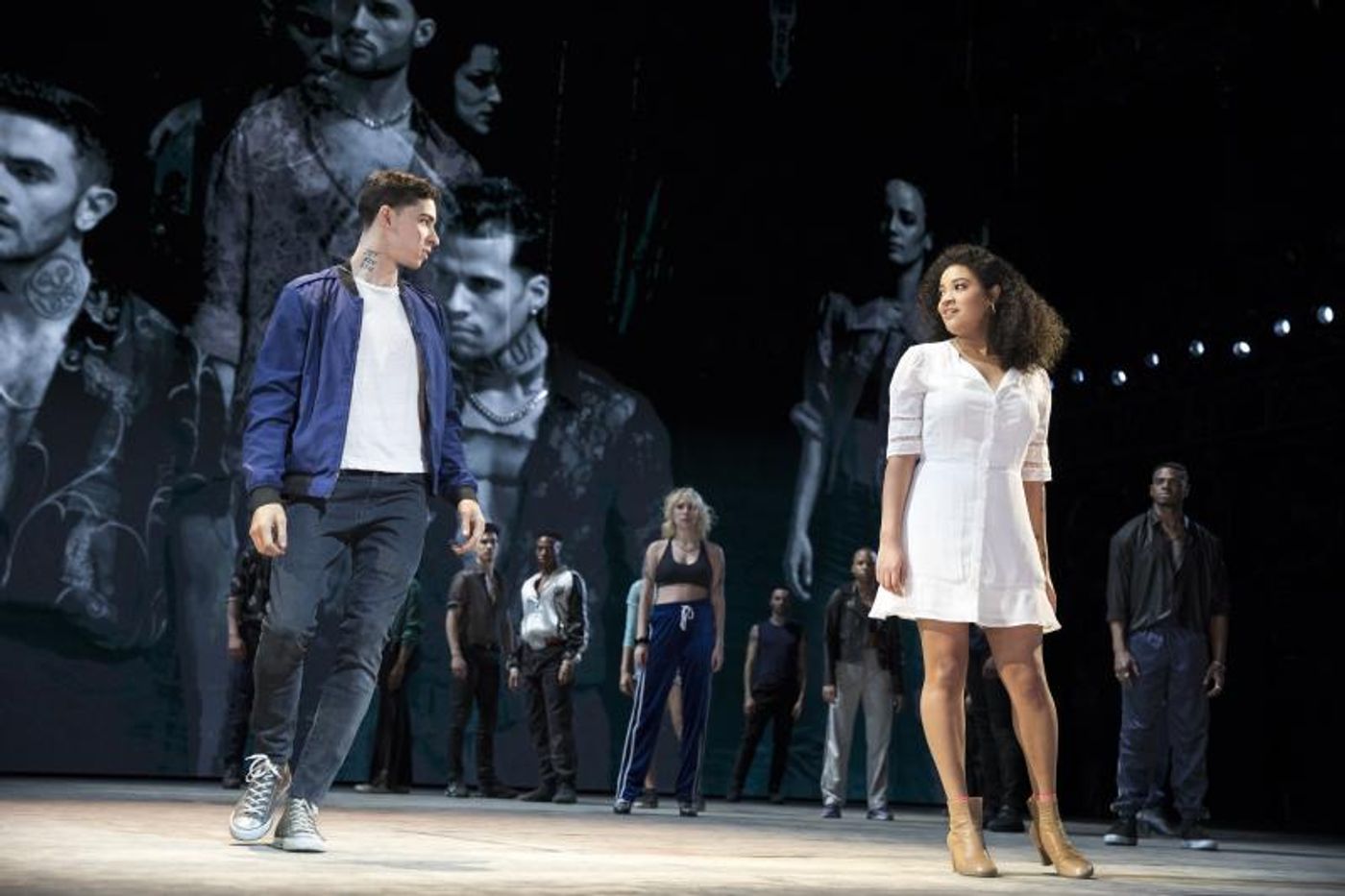
"There is a certain codified language in Broadway. How a number has to end, how you have to build tension. And it's true, I don't have much experience about that," De Keersmaeker explained, "I think finally it turned out well, but I would be lying if I said it went smoothly."
Despite the many challenges of getting the production on its feet, Ivo van Hove's revival of West Side Story opened at the Broadway Theater on February 20, 2020. The production sharply divided critics, but received favorable reviews overall for its ingenuity and innovation.
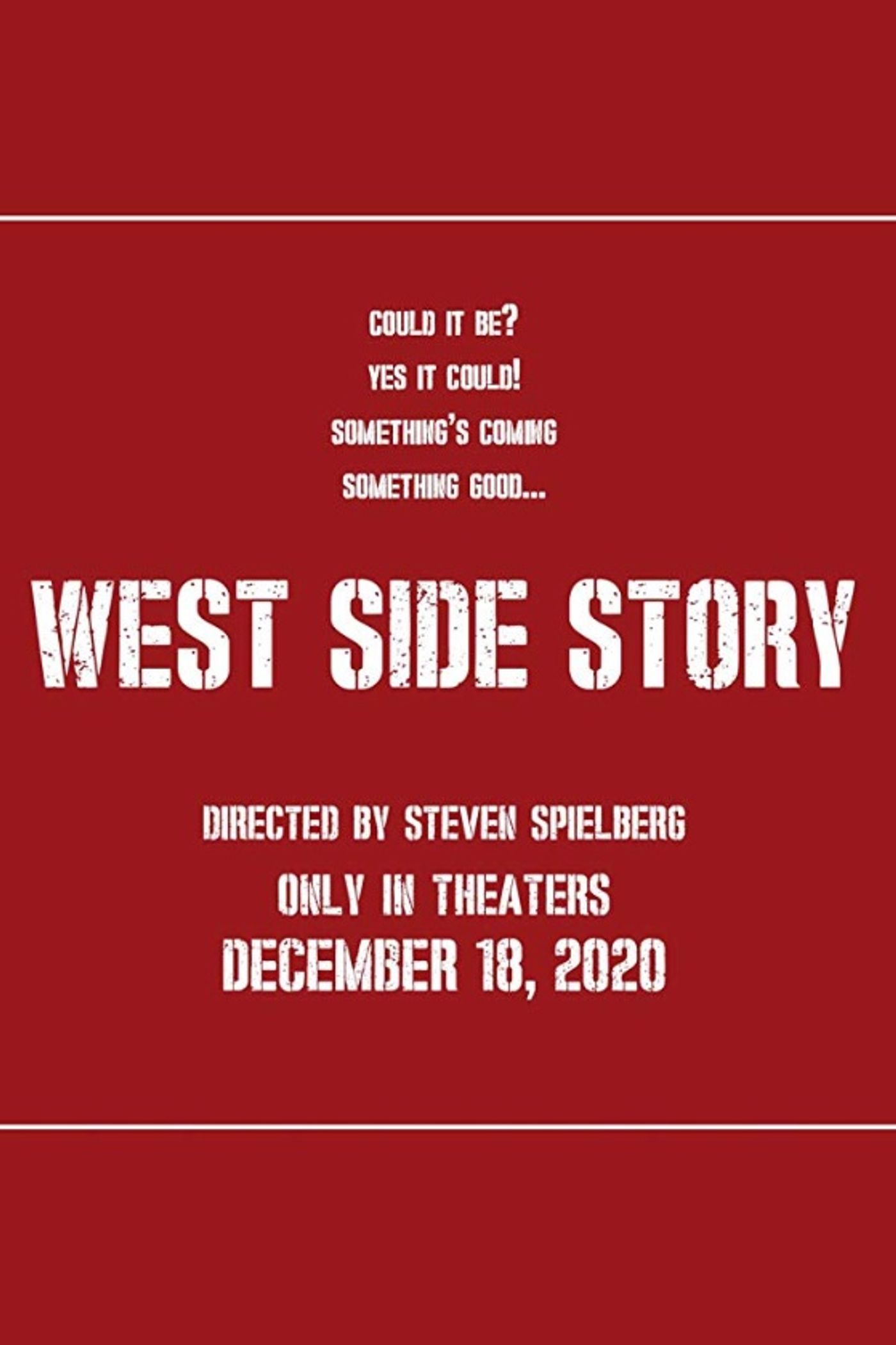 The next chapter in the West Side Story saga is set to begin this Christmas with a brand-new big screen retelling of the story from Academy Award-winning director, Steven Spielberg and Pulitzer Prize-winning playwright Tony Kushner.
The next chapter in the West Side Story saga is set to begin this Christmas with a brand-new big screen retelling of the story from Academy Award-winning director, Steven Spielberg and Pulitzer Prize-winning playwright Tony Kushner.
Though details for the film have been kept mostly under wraps, the new telling appears to be yet another departure from its source material, as Kushner revealed that while all the musical numbers will be left intact, his take on the story would hew more closely to the stage musical than the 1961 film.
According to Kushner, the new version would also place focus on realism in its casting and storytelling.
"Our version is not meant to wipe out the original film, which is a masterpiece," he says. "I think people will find a new way to love the story and to love the songs through our interpretation. I don't know if 'gritty' is necessarily the right word, but there are aspects of urban life in '57, '58, '59 that weren't touched on in the 1961 movie. But it's definitely the Jets and the Sharks. It's New York City. The way I approached it and the way Steven is approaching it is using the great text: the Leonard Bernstein score, which is arguably the most beautiful score ever written for musical theatre, and Arthur Laurents's original book is a masterpiece. And we started building from that. There are many different versions possible of a great work of art like West Side Story."
Rounding out the team for the film are Tony Award-winning choreographer Justin Peck, acclaimed conductor Gustavo Dudamel, Oscar-nominated composer and conductor David Newman, Tony Award-winning composer Jeanine Tesori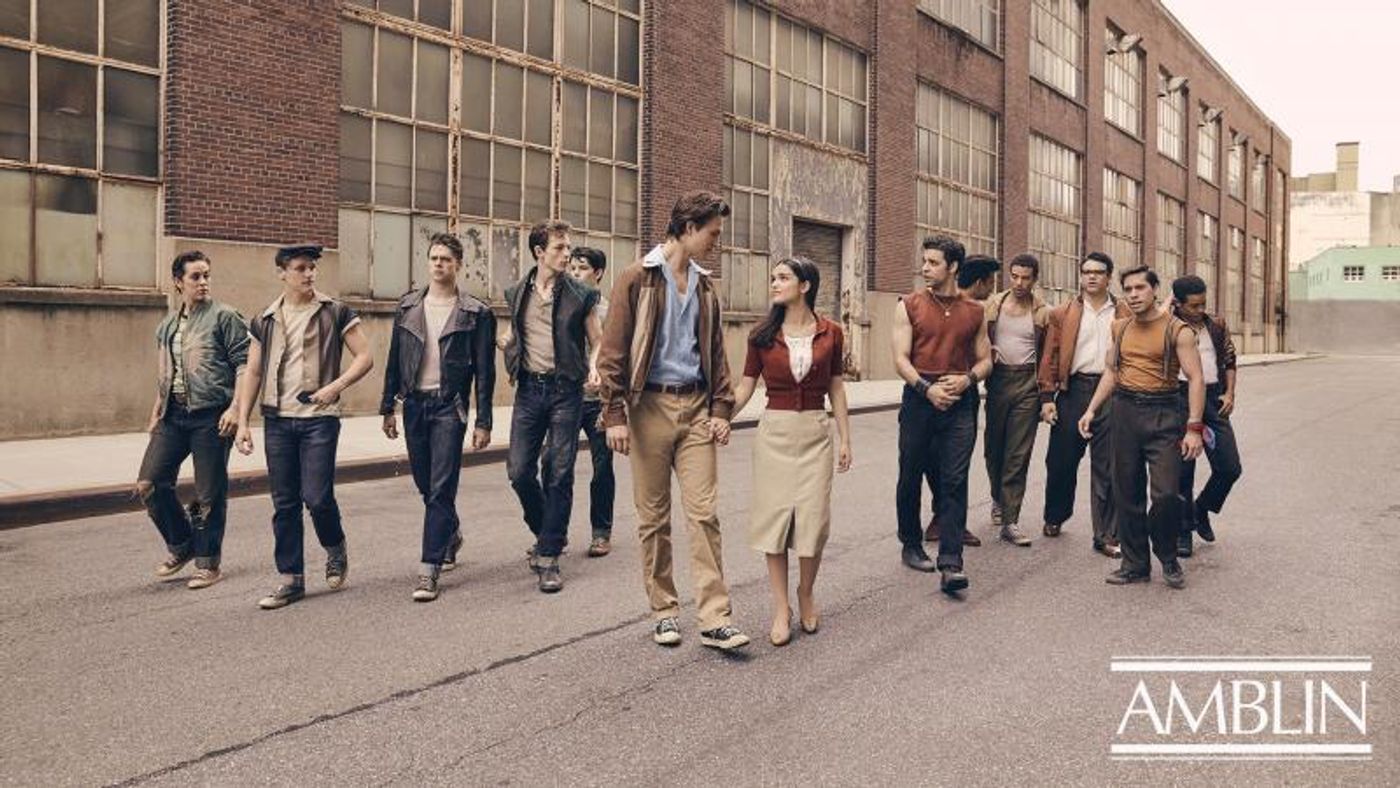 , and Grammy-nominated music supervisor Matt Sullivan, who also serves as executive music producer for the film.
, and Grammy-nominated music supervisor Matt Sullivan, who also serves as executive music producer for the film.
Official casting began to roll out in October 2018, leading with film star Ansel Elgort who had signed on to play Tony. It was then announced that Rita Moreno. who won an Academy Award for her portrayal of Anita in the original film. would return to the West Side as Valentina, a female take on candy shop owner, Doc, as the voice of reason among the warring teens. Moreno also serves as an executive producer on the project.
 "From our earliest discussions, we wanted to include Rita Moreno in our production," Spielberg added. "Her Anita is one of the greatest musical performances ever filmed, and a personal favorite of mine. We created an original role for her, and we feel beyond fortunate that Rita will bring her extraordinary gifts as an actress, as well as her deep understanding of West Side Story to this production as an executive producer."
"From our earliest discussions, we wanted to include Rita Moreno in our production," Spielberg added. "Her Anita is one of the greatest musical performances ever filmed, and a personal favorite of mine. We created an original role for her, and we feel beyond fortunate that Rita will bring her extraordinary gifts as an actress, as well as her deep understanding of West Side Story to this production as an executive producer."
Lend her expertise, she did, beginning with notes on the Spanish used in the script's early drafts.
"I didn't know how to say that to Steven," Moreno said. "Finally, in our conversation on the phone . . . I said, 'Listen, Steven, I don't know if you're aware of this, but the Spanish in the script is not terrific."
Spielberg, she says, immediately mollified her concerns, "He said, 'Oh, no, no, no, that's Tony Kushner using a Spanish dictionary.' I was very nervous that Steven would 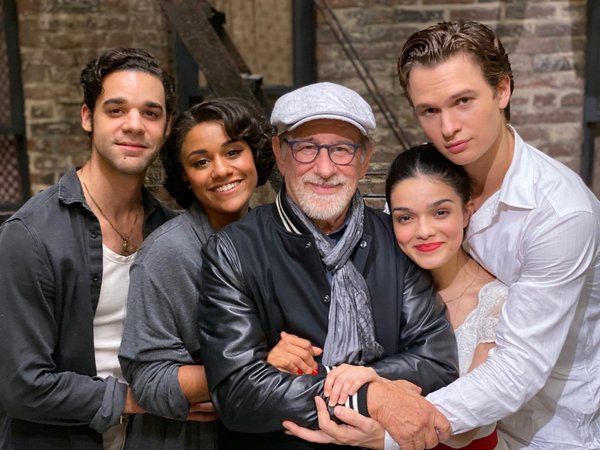 think that that was the correct thing."
think that that was the correct thing."
Rounding out the cast would be Tony-nominee Ariana DeBose as Anita, Tony-winner Ben Alvarez as Bernardo, Tony-nominee Mike Faist as Riff, Tony-nominee Brian d'Arcy James as Officer Krupke, Corey Stoll as Lt. Shrank, Josh Andrés Rivera as Chino. and bright young newcomer, Rachel Zegler, a New Jersey high school student, as Maria.
Though there is no word on whether or not choreographer Justin Peck intends to keep Robbins' original choreography intact, his roots in the ballet world suggest that his work will hew more closely to the original than the current Broadway production.
Filming began in New York City in the summer of 2019 with additional locations in northern New Jersey and Brooklyn. The movie wrapped filming on September 20, 2019 and was scheduled for release the following year, on December 20, 2020.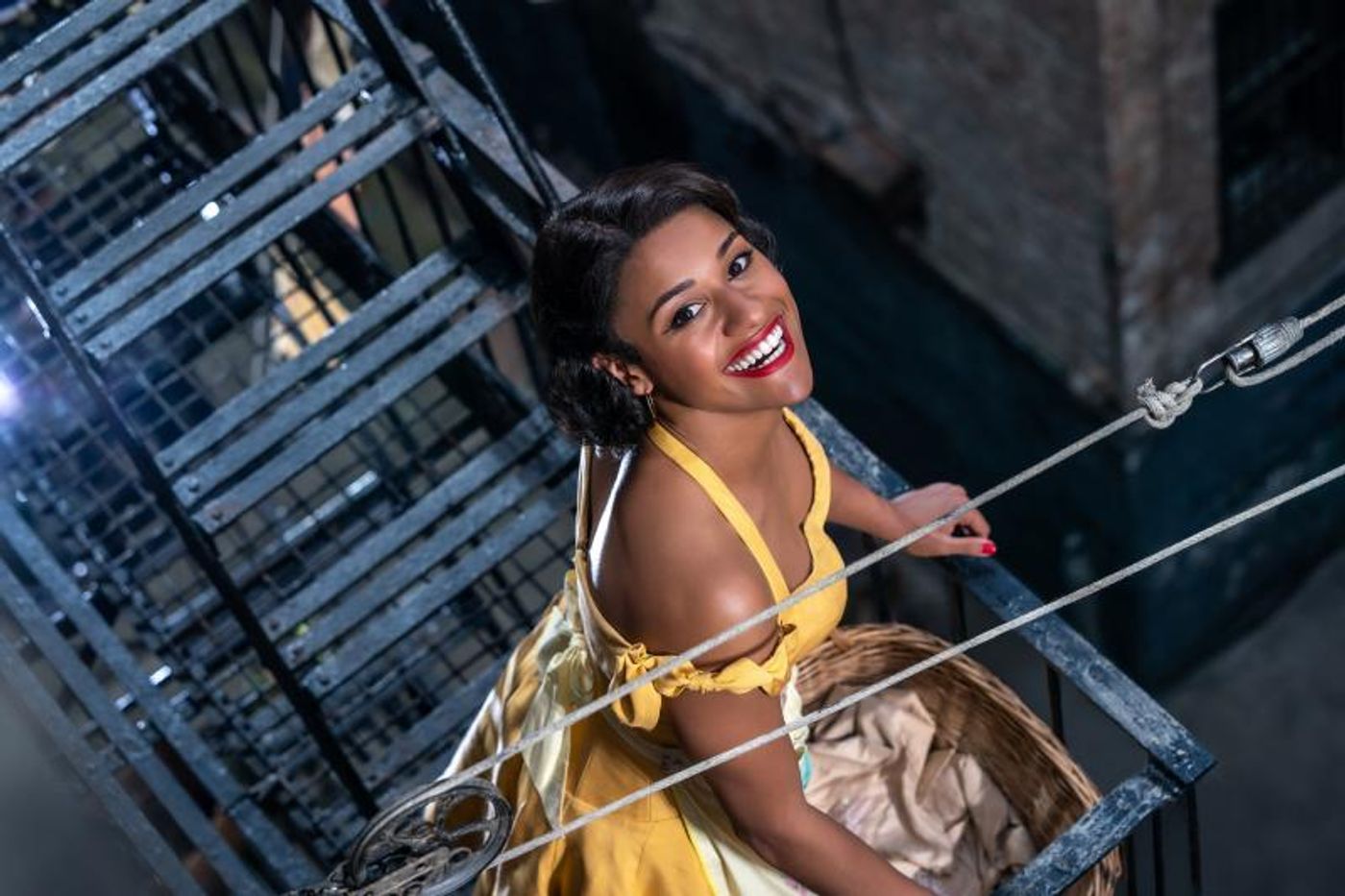
"This has been a journey without precedence: a joyful, stunning, moving, endlessly surprising encounter with the story and score of one of the world's greatest musicals," Spielberg wrote in a letter after filming wrapped. "My brilliantly talented, fiercely committed, generous and apparently inexhaustible cast and crew of hundreds have given our film everything they've got, and already I can say that the film we'll be releasing on December 18, 2020, owes everything to them as does its immensely grateful director."
He continued: "We filmed West Side Story all over New York, Flatbush to Fort Tryon Park. The city lent us its beauty and its energy, and we drew deeply upon its grand multicultural, multifaceted spirit."
The journey of West Side Story is one of the longest and most storied in the history of musical theatre.
The history put forth here accounts for only a fraction of the show's legacy. and omits the many additional ways it has been interpreted by symphony orchestras, dance companies, and opera houses all over. And therein lies the key to West Side Story's magic as a piece that transcends the limitations of musical theatre: Each facet of the work - Robbins' staging, Sondheim's poetry, Laurents' book, and Bernstein's score - have the unique the ability to stand on their own and tell just as vivid a story. The author's mismatched intents, once the greatest handicap to getting the show on its feet, is now the West Side Story's greatest strength. Each element is its own fully-formed masterwork, put forth by the some of greatest minds the art form has ever known.
What we are left with is a transcendent piece of musical theatre and the simple hope that somehow, someday, somewhere we will know a kinder and more accepting world. The nuance of that hope is, of course, perfectly underscored in the show's closing notes as Bernstein answers the optimistic strains of "Somewhere" with foreboding lower tones, ultimately ending on the question of whether such a place truly exists and leaving it up to us to create it for ourselves. In that way, no matter the staging or setting, the DNA of West Side Story can never truly be altered.
Photo Credits:
West Side Story (Broadway 1957)
- The Rumble - Photo by Fred Fehl / Public Domain
- Balcony - Photo by Fred Fehl / Public Domain
- Larry Kert as Tony - Photo by Fred Fehl / Public Domain
- Gee, Officer Krupke - Photo by Fred Fehl / Public Domain
- I Feel Pretty - Photo by Fred Fehl / Public Domain
- The Jets - Heyszilard0 / CC BY-SA (https://creativecommons.org/licenses/by-sa/4.0)
- Jerome Robbins - Walter McBride
- Leonard Bernstein - Pertti Jenytin / Lehtikuva / Public Domain
- Playbill - Billy Rose Theatre Division, The New York Public Library. "West side story" The New York Public Library Digital Collections. 1957. http://digitalcollections.nypl.org/items/7715284d-9474-5dfd-e040-e00a1806474d
West Side Story (1961 Film)
- Set Designer. Boris Leven, with set sketch - Unknown (United Artists) / Public Domain
- George Chakiris - West Side Story / Public Domain
- Film Poster - English: Designed by Joe Caroff. "Copyright © 1961 United Artists Corporation." / Public Domain
- Rita Moreno - Jac. de Nijs / Anefo / CC0
- Natalie Wood - Unknown Photographer / Public Domain
West Side Story (Broadway 2009)
West Side Story (Broadway 2020)
- Production Images - Julieta Cervantes/ Jan Versweyveld
West Side Story (2020 Film)
- Cast Photo - 20th Century Fox/Amblin Entertainment
- Steven Spielberg and Cast - 20th Century Fox/Amblin Entertainment
- Steven Spielberg and Rita Moreno - 20th Century Fox/Amblin Entertainment
- Ariana DeBose as Anita - 20th Century Fox/Amblin Entertainment
Powered by
|
Videos

